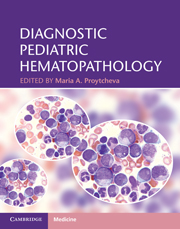Book contents
- Frontmatter
- Contents
- List of contributors
- Acknowledgements
- Introduction
- Section 1 General and non-neoplastic hematopathology
- Section 2 Neoplastic hematopathology
- 10 Chromosome abnormalities of hematologic malignancies
- 11 Expression profiling in pediatric acute leukemias
- 12 Myeloproliferative neoplasms
- 13 Myelodysplastic/myeloproliferative neoplasms
- 14 Myelodysplastic syndromes and therapy-related myeloid neoplasms
- 15 Acute myeloid leukemia and related precursor neoplasms
- 16 Hematologic abnormalities in individuals with Down syndrome
- 17 Precursor lymphoid neoplasms
- 18 Advances in prognostication and treatment of pediatric acute leukemia
- 19 The effect of chemotherapy, detection of minimal residual disease, and hematopoietic stem cell transplantation
- 20 Pediatric small blue cell tumors metastatic to the bone marrow
- 21 Pediatric mature B-cell non-Hodgkin lymphomas
- 22 Pediatric mature T-cell and NK-cell non-Hodgkin lymphomas
- 23 Hodgkin lymphoma
- 24 Immunodeficiency-associated lymphoproliferative disorders
- 25 Histiocytic proliferations in childhood
- 26 Cutaneous and subcutaneous lymphomas in children
- Index
- References
21 - Pediatric mature B-cell non-Hodgkin lymphomas
from Section 2 - Neoplastic hematopathology
Published online by Cambridge University Press: 03 May 2011
- Frontmatter
- Contents
- List of contributors
- Acknowledgements
- Introduction
- Section 1 General and non-neoplastic hematopathology
- Section 2 Neoplastic hematopathology
- 10 Chromosome abnormalities of hematologic malignancies
- 11 Expression profiling in pediatric acute leukemias
- 12 Myeloproliferative neoplasms
- 13 Myelodysplastic/myeloproliferative neoplasms
- 14 Myelodysplastic syndromes and therapy-related myeloid neoplasms
- 15 Acute myeloid leukemia and related precursor neoplasms
- 16 Hematologic abnormalities in individuals with Down syndrome
- 17 Precursor lymphoid neoplasms
- 18 Advances in prognostication and treatment of pediatric acute leukemia
- 19 The effect of chemotherapy, detection of minimal residual disease, and hematopoietic stem cell transplantation
- 20 Pediatric small blue cell tumors metastatic to the bone marrow
- 21 Pediatric mature B-cell non-Hodgkin lymphomas
- 22 Pediatric mature T-cell and NK-cell non-Hodgkin lymphomas
- 23 Hodgkin lymphoma
- 24 Immunodeficiency-associated lymphoproliferative disorders
- 25 Histiocytic proliferations in childhood
- 26 Cutaneous and subcutaneous lymphomas in children
- Index
- References
Summary
Non-Hodgkin lymphomas (NHLs) comprise approximately 10% of all childhood cancers and are a diverse collection of malignant neoplasms of lymphoreticular cells [1]. Pediatric NHL includes a varied group of neoplasms that derive from both mature and immature (blastic) cells of both B-cell and T-cell origin (Table 21.1). NHLs in children are typically intermediate to high-grade (clinically aggressive) tumors. This is in direct contrast to NHL in adults, in which more than two-thirds of the tumors are indolent, low-grade malignancies [2–5]. Pediatric NHL also appears very different from adult lymphomas in that nearly all of the tumors are diffuse neoplasms, and follicular (nodular) lymphomas are exceedingly rare. Pediatric NHL is nearly evenly split between B-cell and T-cell neoplasms, whereas in adults nearly 80% of NHLs are of B-cell phenotype. In addition, pediatric populations have a high incidence of precursor (lymphoblastic) lymphomas, whereas nearly all adult lymphomas arise from mature B- and T-cells [3–4, 6–8].
Diagnosis of pediatric NHL requires similar approaches to those used in adults. Pediatric NHLs are usually aggressive, fast-growing neoplasms that require efficient and appropriate handling of pathologic materials to ensure that a diagnosis can be established (Table 21.2) [9–10]. Morphology and immunophenotype provide the cornerstones of diagnosis, with some problematic cases requiring additional diagnostic ancillary testing, including cytogenetics (to identify specific recurrent cytogenetic abnormalities) or molecular studies (to determine clonality or specific translocations).
- Type
- Chapter
- Information
- Diagnostic Pediatric Hematopathology , pp. 395 - 428Publisher: Cambridge University PressPrint publication year: 2011
References
- 2
- Cited by



